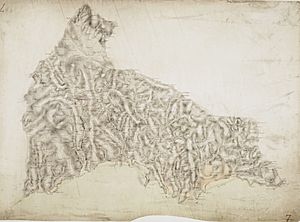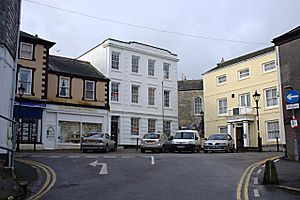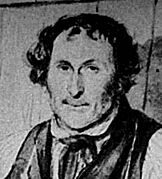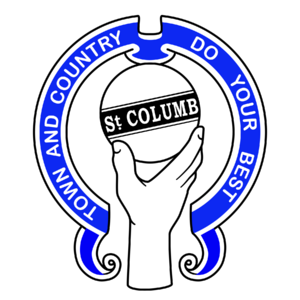St Columb Major facts for kids
Quick facts for kids St Columb Major
|
|
|---|---|
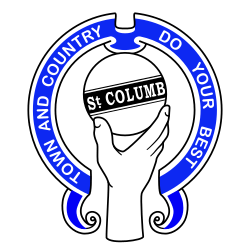 The crest of St. Columb with town motto |
|
| Lua error in Module:Location_map at line 530: Unable to find the specified location map definition: "Module:Location map/data/Cornwall (mainland)" does not exist. | |
| Population | 4,681 (2011 Census) |
| OS grid reference | SW912633 |
| Civil parish |
|
| Unitary authority | |
| Ceremonial county | |
| Region | |
| Country | England |
| Sovereign state | United Kingdom |
| Post town | ST. COLUMB |
| Postcode district | TR9 |
| Dialling code | 01637 |
| Police | Devon and Cornwall |
| Fire | Cornwall |
| Ambulance | South Western |
| EU Parliament | South West England |
| UK Parliament |
|
St Columb Major is a historic town and civil parish located in Cornwall, England, in the United Kingdom. People often call it St Columb for short. It's about 7 miles (11 km) southwest of Wadebridge and 6 miles (10 km) east of Newquay. The name Major helps tell it apart from a nearby coastal town called St Columb Minor. In 2011, the area had a population of 5,050 people. The town gets its name from a 6th-century saint named Columba of Cornwall.
Twice a year, St Columb Major hosts a special medieval game called "hurling". This game used to be played all over Cornwall, but now you can only see it here and in St Ives. It happens on Shrove Tuesday and then again eleven days later on a Saturday. The game involves two large teams: the 'townsmen' and the 'countrymen' from St Columb parish. Their goal is to carry a silver ball to goals that are 2 miles (3.2 km) apart. Sometimes, they even try to get the ball across the parish boundary! This makes the parish, which is about 17.2 square miles (44.5 km²) big, one of the largest sports grounds in the world.
Contents
Exploring St Columb Major's Past
Ancient Times: Bronze and Iron Ages
St Columb Major has many old monuments from the Bronze Age and Iron Age. These include Castle an Dinas, which was a large hillfort used for defense. You can also find the Nine Maidens stone row, which is the longest line of standing stones in Cornwall. Another interesting site is the Devil's Quoit, sometimes called King Arthur's Quoit. There was also a lost stone called King Arthur's Stone, said to have four deep horseshoe marks from Arthur's horse when he hunted on the moors.
Medieval and Early Modern Periods
In the parish, you can see four old Cornish crosses. Two are in the churchyard, one is at Black Cross, and another at Black Rock.
In 1333, King Edward III gave St Columb Major the right to hold a market. This was a reward for the town helping him with troops in a battle against the Scottish.
After the Prayer Book Rebellion in 1549, the mayor of St Columb, William Mayow, faced harsh consequences for leading an uprising. The Cornish language and Catholicism were also linked through John Kennall, who continued to hold Mass in St Columb as late as 1590.
During the English Civil War in 1645, a battle took place near St Columb. Sir Thomas Fairfax's army fought against the King's forces, and Fairfax's side won.
In 1676, a big accident happened when three young people from the town accidentally blew up a large part of the St Columb church with gunpowder.
The 20th Century and Beyond
St Columb Major has welcomed royalty several times. In 1909, the Prince of Wales (who later became King George V) and his wife visited to open the Royal Cornwall Agricultural Show. In 1977, Queen Elizabeth II and Prince Philip came during their Silver Jubilee tour. Later, in 1983, Prince Charles and Princess Diana visited to celebrate 650 years since the town was granted its charter. A special plaque marks this visit.
In 1992, a famous Australian stuntman named Matt Coulter, also known as The Kangaroo Kid, set a record here. He made the longest jump with a crash on a quad bike at Retallack Adventure Park.
Geography and Nature Around St Columb Major
St Columb is in the middle of Cornwall, about 5 miles (8 km) away from the north coast.
The parish covers a large area of about 20.1 square miles (52 km2). Its highest point is Castle an Dinas, which is 709 feet (216 m) high. Most of the land is used for farming, but there are also small woodlands and moorland areas, like parts of Goss Moor. The beautiful Vale of Lanherne, a valley with the River Menalhyl, connects St Columb to St Mawgan.
The Town's Layout
St Columb sits on a flat area about 300 feet (90 m) high. The northern part of the town, called 'Bridge', goes down into the Vale of Lanherne. The town first grew along a main road, but newer housing areas have been built to the south and east. The older parts have narrow streets and many shops and pubs. To the south, there's an industrial area.
Villages and Hamlets
Besides the main town, the parish includes many smaller villages and hamlets. Some of these are Talskiddy, Gluvian, Ruthvoes, Trebudannon, Tregaswith, and Tregatillian. There are also many smaller farming settlements and isolated homes.
Rivers and Waterways
Several small rivers and streams flow through St Columb parish, mostly from east to west. One of the sources of the River Fal is within the parish boundary on Goss Moor. The River Menalhyl flows through the northern part of St Columb. It has three branches that meet east of the town. This river was very important in the past because it powered many mills. Another river, often called the River Porth, starts near Ruthvoes and fills the Porth Reservoir before reaching the sea at St Columb Porth. Legend says this river began with the blood of the murdered Saint Columba.
Protected Natural Areas
Borlasevath and Retallack Moor is a special area known as a SSSI. It's important for its unique plants and animals and is located south of Nine Maidens.
Transportation Links
The A39 main road runs through the parish. It used to go through the town, but now a bypass takes traffic around St Columb to the east. The A30 dual carriageway also passes through the southeastern part of the parish. The Par-Newquay railway line forms part of the parish's southern boundary. A small part of Newquay Airport, Cornwall’s main airport, is also within the parish.
Buildings and Architecture
The older part of St Columb follows a straight line along Fair Street and Fore Street. Many houses on the narrow main street have slate tiles on their walls. The famous Cornish architect Silvanus Trevail designed Lloyds Bank and the local school. He also designed private homes like Ashleigh House and Treventon House. Architect William White designed Bank House, Rosemellyn House, and Penmellyn House. He also made changes to Trewan Hall. The Retreat building used to be the St Columb Workhouse and was designed by George Gilbert Scott. Recently, many new, high-quality buildings have been built on the edges of town, such as Jenner Parc and Arundell Parc. Other notable buildings include Barclays Bank, the Red Lion pub, and the town hall. The oldest house in St Columb is the Glebe house.
St Columba's Church
The church is named after Saint Columba, a local saint. Her holy well is in Ruthvoes. For many centuries, the church was connected to the wealthy Arundell family of Lanherne, who gave it many gifts. The church once had two special chapels with six priests.
The church tower is a beautiful example of 15th-century building style. It has four levels with battlements and pinnacles, standing 80 feet (24 m) tall. It holds eight bells that were re-hung in 1950. In 1920, a chiming clock was added to the tower to remember the men from St Columb who died in the Great War. In 1860, there were plans for St Columb church to become the main cathedral for Cornwall, but the cathedral was eventually built in Truro instead.
The church is also a place where the "Classic Cornwall" music festival is held.
St Columba's Holy Well
50°24′22″N 4°54′29″W / 50.406°N 4.908°W The holy well dedicated to Saint Columba is next to the small village of Ruthvoes, about 2 miles (3.2 km) from the town. Legend says that Saint Columba was beheaded here. The well is close to the A30 dual carriageway and the Par to Newquay railway line.
Cornish Wrestling Tradition
St Columb has been a very important place for Cornish wrestling for hundreds of years.
Wrestling tournaments for prizes have been held in many places around town, including the Red Lion Hotel, fields at Bospolvens and New Road, the recreation ground, and the St Columb School playing field.
Richard Parkyn (1772-1855) is perhaps the most famous Cornish wrestler. He was from St Columb Major and was known as "The Great Parkyn." He was a top wrestler from 1795 to 1811. He was so famous that a small village called Parkyn's Shop was named after him!
James Polkinghorne (1788–1851) was a pub owner in St Columb Major. He was another very famous Cornish wrestling champion. He had many well-known matches against fighters from Devon, like Flower, Jackman (in 1816), and Abraham Cann (in 1826). These matches attracted huge crowds, sometimes as many as 17,000 people! There's a large carved marble memorial about the Cann fight on the front of the Red Lion pub.
Today, there's a Cornish wrestling club open to everyone. It meets every Friday evening at the St Columba Centre.
St Columb Town Crest
The town's crest shows a hand holding a silver hurling ball. Its motto is "Town and Country do your best." This design first appeared on medals given to winners of the hurling game in the 1930s. Later, the town council adopted it as a symbol of local pride. You can see this emblem on the mayor's chains, on the uniform of St Columb School, and on road signs at the entrances to the town.
Education
St Columb Major has a primary school called St Columb Major ACE Academy. It is part of a larger group of schools called the Atlantic Centre of Excellence Multi Academy Trust.
Local Businesses and Attractions
Main Employers
- Pall Corporation: This company works with filtration and separation technology. It employs 300 people in St Columb.
- Mole Valley Farmers: This business provides supplies and equipment for farming. It opened in 1986.
- St Austell Breweries: This company has a distribution center here, which opened in 2009.
- Western Flat Roofing Co.
Nearby Tourist Attractions
- Cornish Birds of Prey Centre
- Camel Creek Adventure Park
- Screech owl sanctuary
- Springfields Fun Park
- Retallack Resort and Spa
See also
 In Spanish: St Columb Major para niños
In Spanish: St Columb Major para niños


